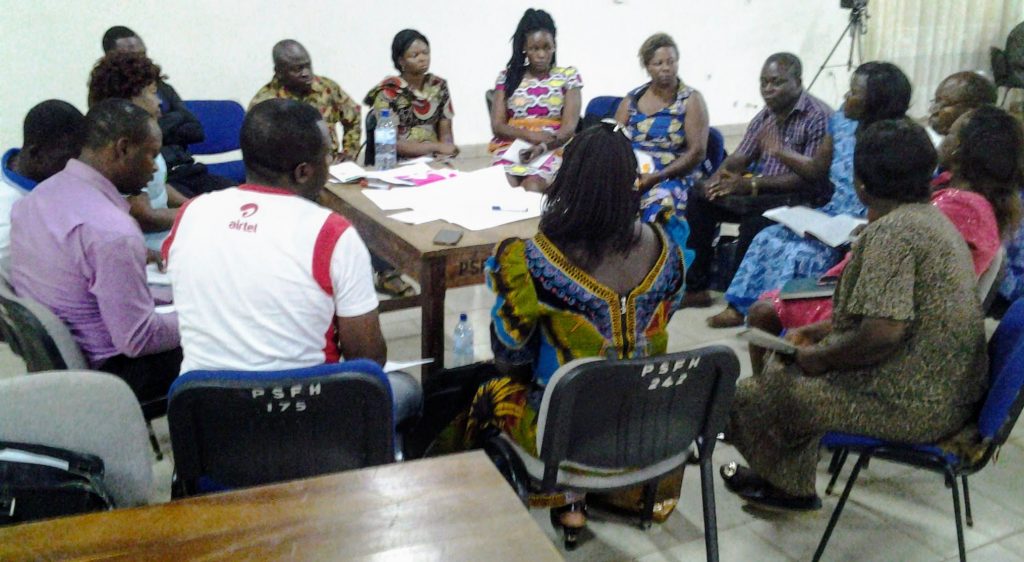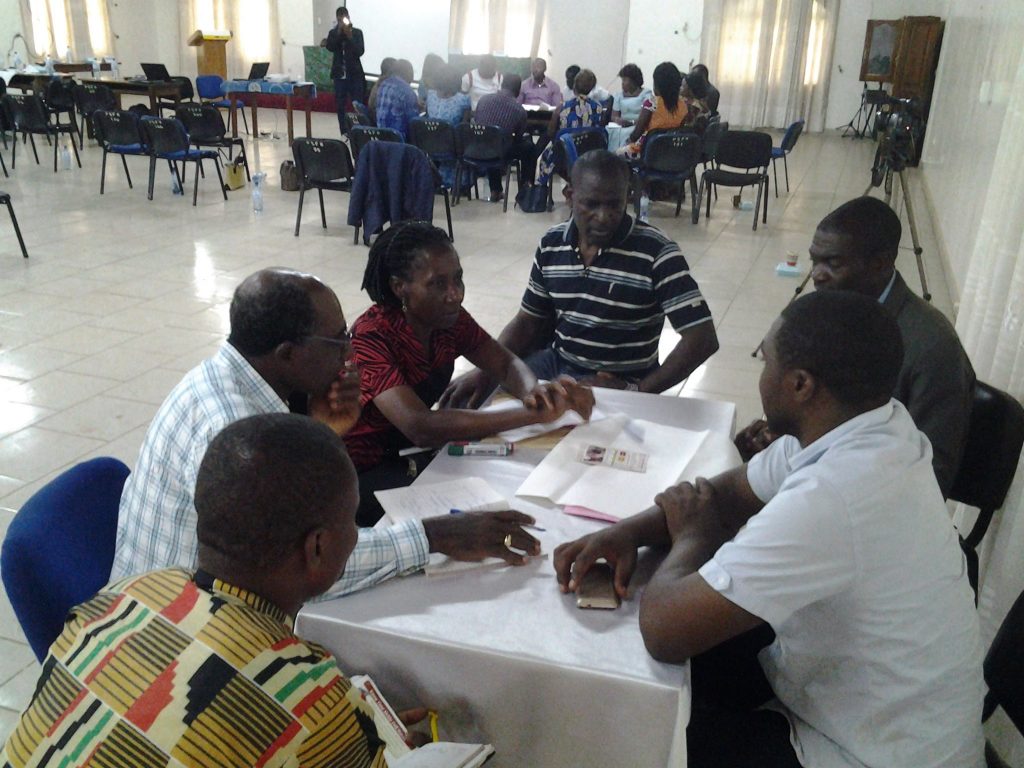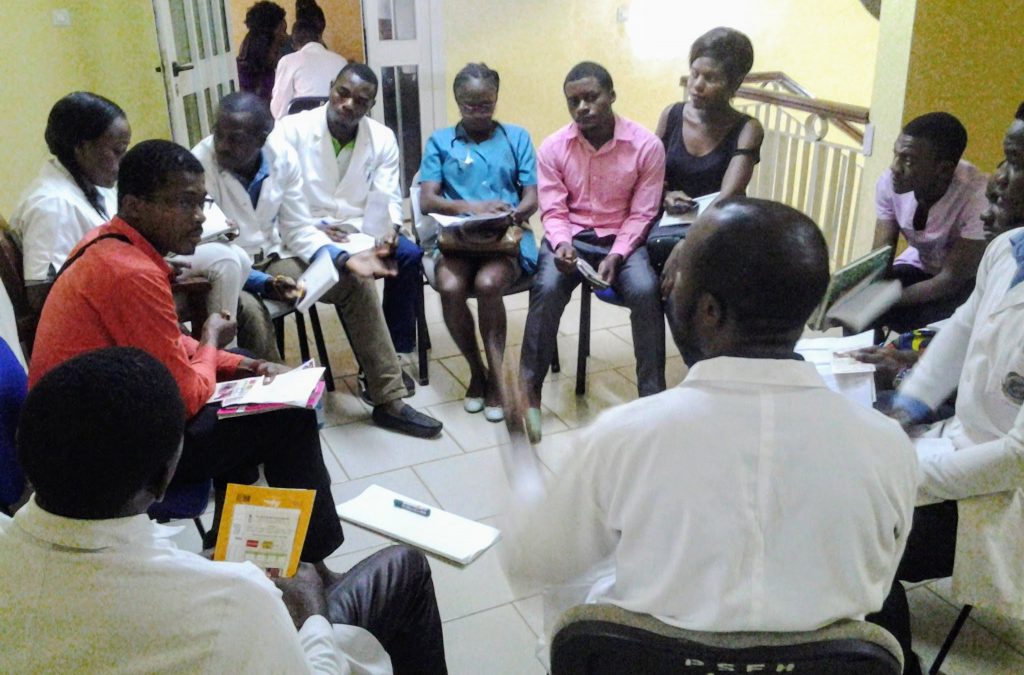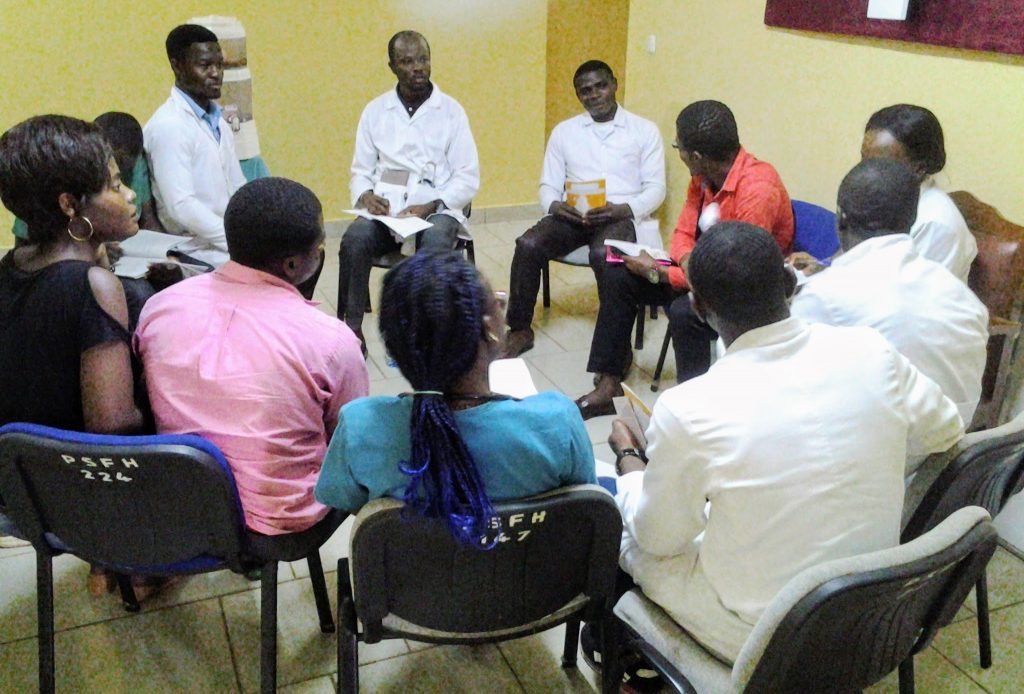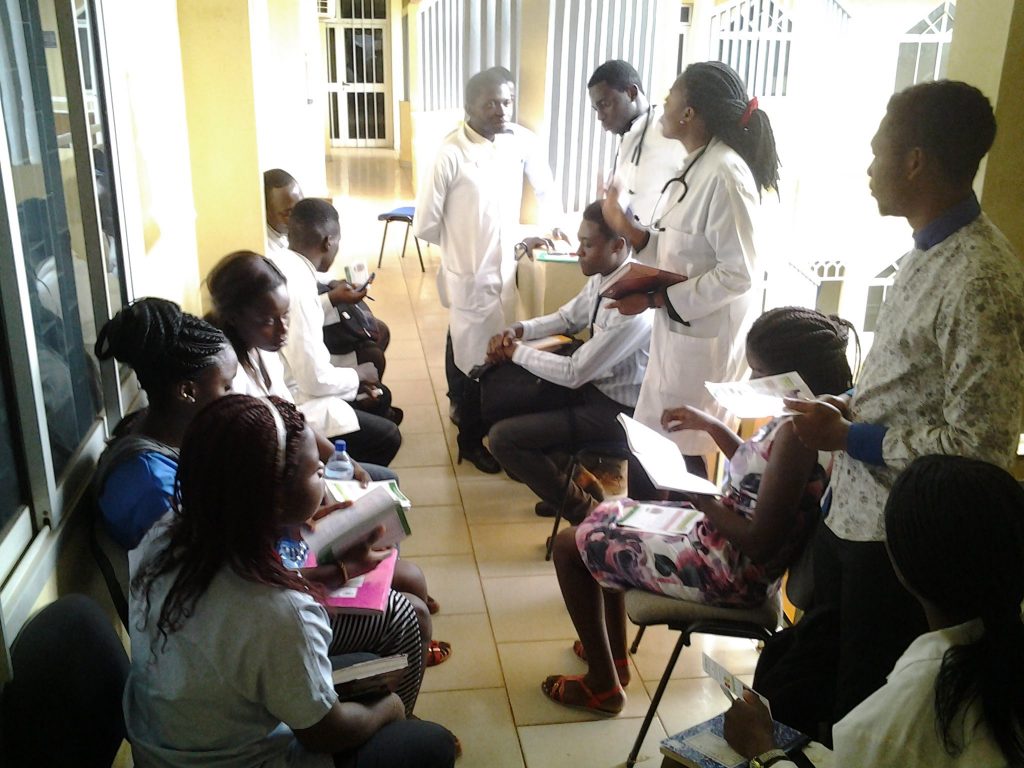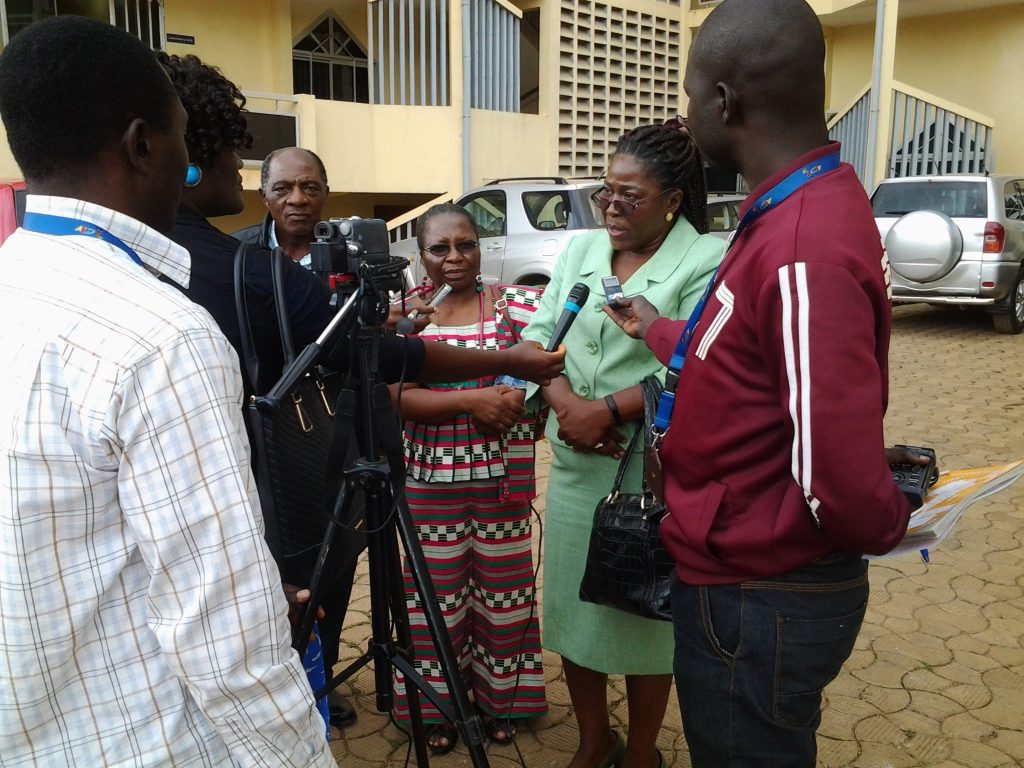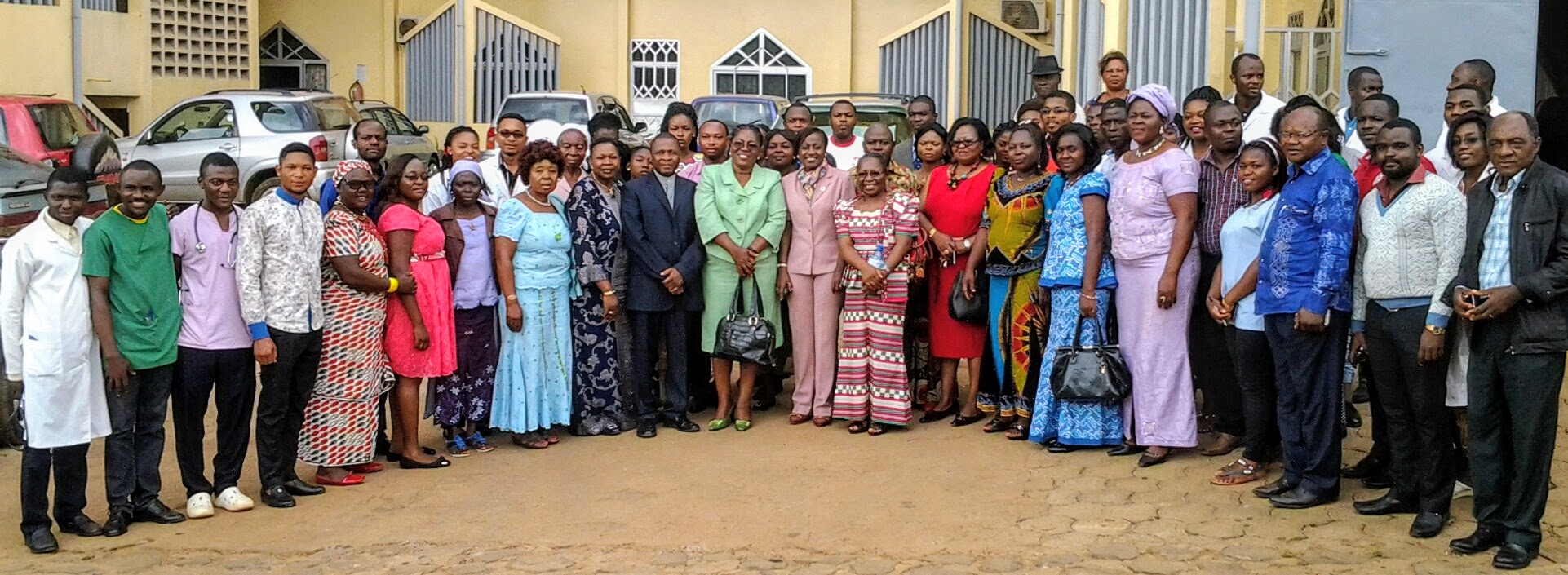
c
c
c
.
.
SCAF | Sickle Cell Action Framework
Where and how does one begin to formulate a sickle cell disease management program? There is a lot of information on Sickle Cell Disease, from causes, through history, research areas and methods, management, education and therapy. This can be overwhelming especially for those who are new to, and want to start a new program. Sickle Cell Action Frame (SCAF) provides a reference or starting point. SCAF is for everyone; it has something for everyone.
Foreword
Sickle Cell Disease (SCD) is a hereditary disease occurring mostly in sub-Saharan Africa. It accounts for close to 15% of deaths in children under five in some West African countries. In Cameroon, the awareness and knowledge of the disease is limited and health institutions providing care are also few and located mainly in large urban centers, thus inaccessible to local communities. In the Northwest region, 60% of identified SCD patients are under 10 years old. Most affected families are unable to afford the necessary health care for these inflicted children.
SCD is a public health problem and as such, the Ministry of Public Health is trying to implement recommendations set by the World Health Organization (WHO). Since 2012, the North West (NW) Regional Delegation has partnered with FJK Sickle Cell Foundation in the prevention and provision of health care services to the local communities of the NW region. The initial intervention included: early diagnosis, treatment of complications and support to suffering families.
Despite all of these, there is an urgent need for a framework to enable proper coordination of Sickle Cell Disease management in the region. Such a document will be useful to health professionals, other caregivers and training schools.
The NW Regional Delegation of Public Health in collaboration with FJK Sickle Cell Foundation has drawn up this Sickle Cell Action Framework (SCAF) which actually defines the purpose, objectives and priority interventions that provide solutions to gaps experienced in the managing of SCD in our communities. In addition, this framework has taken into consideration the integration of existing health policies.
I am convinced that this SCAF will enhance the participation of all stakeholders involve in the prevention and management of SCD in our health institutions and communities.
Therefore, I invite all actors to source from this document so as to galvanise our actions towards the prevention and control of SCD in the NW region and beyond.
Dr MANJO MATILDA FON
Introduction
This framework defines the direction for sickle cell health care and priority interventions that reflect the challenges of Sickle Cell Disease (SCD) in our community.
SCD is nothing new in Cameroon. It is known by various names in different localities, depending on the complication and the experience of the affected and inflicted. Awareness and knowledge of the disease is limited or absent. Its management is primarily ad hoc. In the domain of SCD, things are happening: sporadic care is being provided to children, partnerships with community based organizations are being built, traditional and conventional treatments are sought, families are breaking apart when a child is unexpectedly diagnosed with the disease, and some level of research is going on. Despite all of this, there is currently no framework for managing sickle cell disease in Cameroon, particularly in the North West Region (NWR) where medical resources are low and medical research on the disease has not been examined. Little or nothing is known about SCD, Hbc and trait incidence.
There is an urgent need to set up a coherent framework whose outcome will be coordinated health care for Sickle Cell (SC) patients and support for families resulting to improved quality of life.
SCAF will be useful to:
- Health professionals working with sickle cell disease.
- Social workers dealing with affected persons and families.
- Educators and health care curriculum developers.
- Parents and families of patients affected with the disease.
- Members of the press and social media.
- The scientific and medical community with interest in SCD research.
- Co-operations as they will realize SCD also affects the very fabric of their businesses.
- Those with an interest in advocacy efforts to address SCD concerns.
SCAF will find application in the development of:
- health care quality controls and protocols.
- special education curriculum.
- sickle cell disease support projects and initiatives.
- internship programs for medical students and institutions.
Framework Development
FJK Foundation has conducted health promotion activities with families and individuals with Sickle Cell Disease in the North West Region and other parts of the country since 2007. This framework draws in part from those activities. It is also based on reviews of other frameworks, and experts’ consultation on the subject.
SCAF has been designed to integrate with existing health care policies and systems at all levels, taking into consideration rapidly emerging technologies.
- Considerations
The following considerations are pivotal to the development of this framework. They are key to developing and implementing sickle cell programs, projects, services and protocols. Sickle cell disease is a:
- Public Health disease or hazard and requires a public health approach to its control and management.
- community disease and its control require input from the community. The community goes beyond the affected child/adult and immediate family.
- non-communicable disease and those suffering from it are not immune to other diseases.
- non-curable disease, its treatment goal, as such is the prevention of its occurrence and complications. Educating the public and individuals is an essential element in the prevention and management of the disease.
- WHO
The framework heavily draws from the WHO African region report on strategies aimed at reducing the incidence, morbidity and mortality due to sickle-cell disease in the African Region. The strategy lists SCD challenges and recommends priority interventions (World Health Organization, 2010) to overcoming them.
- SCD Management Paragon
FJK Foundation developed a SCD management paragon which emphasizes a holistic approach to managing SCD. Patient care is not a dimensional relationship; it is an interdependence relationship with a continuous communication-flow of health care information. It is hoped that the implementation or application of the FJK Care Paragon (see Figure 1) to the development of health care delivery platforms will result to increased participation by program recipients and reduce recipient-fatigue of multiple visits from different programs.
SCAF Components
- Services
Services should be geared towards the adoption of a comprehensive health care management of SCD (World Health Organization, 2010), No. 17-b. Comprehensive health care takes into consideration the whole patient’s needs beyond the medical and physical.
- Awareness and Education
Development of programs and activities that raise awareness, increase knowledge and provide training and information about sickle cell disease to health care professionals, patients, families and the community in which the affected persons reside.
Professional Education and Training
SCD education should be integrated into medical training and curriculums of other professional groups. Professional health care providers should be trained to recognize and address the needs of SCD related complications in patients who may come in with other diseases.
Patient Family Education
Develop patient and family level educational opportunities to increase patient/family knowledge about Sickle cell disorders, and promote self-care and empowerment taking into consideration the socio-cultural and religious background, and literacy levels. Of significance, but often neglected or ignored, and should be considered in patient education, is the significance of nutrition in SCD related complications management.
Public Awareness and Community Education
Development of age appropriate programs and dissemination of information on SCD to targeted diverse audiences.
- Family Support
Organized periodic or as needed psychological and peer support group meetings for families and patients. Support groups create an environment that promotes understanding, exchange of information on SCD and coping strategies to living with the condition.
Religion and spirituality should be a part of the Family Support program or services. Most parents reportedly use religious and spiritual coping strategies to cope with their child’s illness (Cotton, et al., 2009).
- Pain Management
Pain is the climax of sickle cell disease. SCD related pains can be recurring, chronic, acute or a combination of all of these. Pain severity can range from mild to intense. Pain can occur suddenly in any or all parts of the body. Pain management requires an understanding of SCD related pains, assessment tools, pain management principles (NHLBI, 2014) and what medications to use. See WHO Model Lists of Essential Medicines (Panepinto, 2015).
- Clinical Care Services
Clinical care services focus on prevention, recognition, monitoring, treatment and management of SCD complications like strokes, kidney dysfunctions, ulcers, etc. While the center may not be able to handle all these types of complications, appropriate referrals can be made.
- Laboratory
Primary purpose of the laboratory is to identify the presence of Hemoglobin S, evaluate the person’s RBC status, the hemoglobin level and if there are altered hemoglobin gene copies. Testing/Screening should be targeted to family members of an individual with SCD or trait, persons not screened at birth, newborn children whose parents have never been screened or whose parents have SCD or the trait. Additionally, laboratory tests should be used to monitor anemic and iron levels, and other blood related diseases.
- Counseling
Genetic, psychological and nutritional counselling is among the counselling types to be considered.
Non-directive counseling, at all levels (patient, family, pre-nuptial), aimed at helping those being counseled to make informed decisions about health-related and/or family planning issues believed to be in their best interest. Counselling should be done in a manner that is consistent with the level of education, literacy, language, and culture of the individual, family or community.
- Chaplaincy Direction
Chaplaincy direction should be considered as a service to patients and families. The patient’s health assessment and care should include a religious and spiritual dimension. Spirituality is a coping mechanism in a variety of diseases, sickle cell included. Spiritual well-being is important for some patients who must cope with the pain of sickle cell disease (Cooper-Effa, Blount, Kaslow, Rothernburg, & Eckman, 2001).
- Case Management
Case management ensures that the patient and family are aware of resources and accessing them for their use. These can range from various needs and opportunities, counselling and or referrals, follow up on appointments, treatment and education plans.
- The Sickle Cell Center
The Sickle Cell Center is defined as an established facility with an identifiable, functional program or unit within a community. Its ideal primary mission is the provision of comprehensive sickle cell services. It should have a designated address, contact number and specified hours of operations. There should be adequate space for administrative tasks, record keeping, storage, data management and service provision (see service components) that include:
- referrals to appropriate medical teams, diagnostic resources, preventive options.
- monitoring and reporting on the various performance matrices.
A balance in the provision of services as depicted in the management paragon (section 2.2) should be maintained and may vary depending on the circumstances, locality, capacities and competencies (section 3.2.4). At a minimum, diagnosis, education and counselling should be fundamental.
- Advisory Committee
An Advisory Committee is essential to the development and implementation of programs and services for the management of SCD for a given center or program. Composition of the advisory committee should be as diversified as possible to reflect differing views and the community in which the center is located. Committee members’ diversified experiences provide perspectives that will improve the overall patient-family-centered health care experience. The Advisory Committee should be charged with the responsibility of interpreting the center’s work and values to the community while acting as its spokesperson.
- Staff Composition
Staff comprises the required administrative, professional and technical personnel in place for the effective operation of the center. It is an expectation to have a dedicated core team with experience and/or expertise and a clear job description that has staff competencies as base criteria (section 3.2.4). An example of staff composition includes a Program Administrator/Director, Screening Coordinator, Outreach and Education Coordinator, Medical Advisor, Nurse/Counselor, etc.
- Staff Administration
As part of staff administration and training, annual in-service programs should be organized. Documented completion of in-service SCD management programs for new hires should be completed within one year of employment. A staff file should have at a minimum:
- Current vitae and written agreements on file
- Activity and profile record
- Patient/Staff Satisfaction survey
- Appraisal reports
- Staff Competency Areas
The Royal College of Nurses (Anionwu, Tangayi, & Streetly, 2011) developed a set of competency skills for nurses to help them care for and understand the needs of the sickle cell patient. Although developed specifically for nurses, these apply in general to those who support the sickle cell cause. Due to their activity overlap, we have consolidated the ten skills competencies into seven competency categories.
- Self management plan and evaluation
- Empathy and understanding
- Comprehensive physical and needs assessment
- Safe intervention provisions
- Collaboration with patients and families
- Early identification of patient changing condition
- Service improvement and promotion across care continuum
These competencies should be considered in writing job descriptions and included in the criteria for hiring staff.
- Collaboration and Coordination Activities
Established network and linkages should be encouraged and maintained between/among health care service providers and institutions to prevent or minimize resource duplication. Of equal importance is the interaction with the faith, cultural and social group, and traditional leaders of the community.
- Care Protocols
Development of care protocols are fundamental to any service provision in health care and are cited as a priority intervention in SCD management – 19(a) (World Health Organization, 2010). Protocols and elements of care ( Bender & Seibel, 2012) constitute the working standards through which the health care provider and organization can be evaluated, and the quality of services tracked and analyzed. They also ensure consistency in care provision across providers. Protocols are and should be an integral part of the center’s daily workflow (Trivedi, 2014). They should be properly documented as such. Some care protocol examples include:
- Screening and diagnostic testing
- Counseling formats
- Operational manuals and guidelines
- Evaluation procedure of service provision
- Documentation of care provided
- Adolescent to adult transitioning
- Support staff development
- Levels of care and requirements
- Operations
Operations define the day to day functioning of the sickle cell center (program or clinic). There should be defined prinicples of operation and documented policies, standards, guidleines and procedures, and outcomes.
- Principles of Operations
- Ownership
- Accountability
- Partnership and coordination effectiveness and accessibility
- Responsibility
- Community participation
- Disease and related complications prevention focus
- Policies, Standards and Guidelines
- Available and accessible services
- Family/Patient and staff rights
- Confidentiality, privacy and consent
- Management guidelines for care of newborns with SCD
- Ethical and legal issues related to confidentiality and informed consent
- Information Exchange
Commitment to information exchange towards the daily decision making of SCD management, evidence for policy making and health promotion, and the establishment of SCD surveillance System – 17 (c) (World Health Organization, 2010). There is a lack of SCD statistical data in an organized structured form from which inference can be made. Some data exists in inaccessible “closets”. Some areas of urgency to address in the area of information exchange (data collection, storage, analysis and dissemination) include:
- Maintenance of information technology equipment and data in designated information systems and formats.
- Monitoring and reporting of performance indices as required.
- Compliance with regulatory and performance reporting requirements.
- Participation in research and evaluation activities as recommended and directed by Advisory Committee.
- Collection and reporting of screening results, counseling and education event data in accordance with stated data fields and definitions.
- Development and establishment of a Sickle Cell Disease Registry and surveillance system (at a minimum a simple spreadsheet with basic data elements).
- Outcome and Quality of Care Measures
Outcome and quality of care measures are important for the understanding of treatments, outcomes and access to care among those with SCD. These measures can be used to link the activities to public health policy or provide clues about economic impact of the disease is well known. Some selected measures to track include:
- new diagnoses and ages of people with sickle cell disease
- mortality especially under-5-years-old
- lost productivity (school and work) due to SCD care needs
- number of adolescents or prenuptial counseled about SCD
- number of persons who have received routine evaluation in a year
- number of persons taking treatment
- % of persons on nutrition supplementation
- number of SCD-related visits and hospitalizations in a year
- School absences
- % of persons with regular/routine (evaluation) preventable checks
- % of persons who cannot afford care
- number of publications developed and distributed
- number of events and event particpants
- Cost of services
- Governance
- Strategic business alignment
- Roles and responsibilities
- Operational and financial management
- Program evaluation
- Compliance with required regulations and policies
Interventions
WHO has listed a set of priority interventions to address SCD from which an organization can draw from and use in conjunction with local needs as determined from an assessment of the community’s needs. It is not necessary nor is it an expectation that all these interventions be addressed by a single entity. Irrespective of the chosen intervention, the approach and channels to implement it should be within the expected domains and targets for SCD control and management. Interventions should have a base and target without losing focus of the patient.
- WHO Recommended SCD Priority Interventions
Individuals or institutions embarking on advancing the sickle cell cause, in whatever capacity and direction should be familiar with the WHO recommended strategies (no 19, (World Health Organization, 2010)).
- Advocacy for resource mobilization and increased awareness.
- Partnerships and social impact.
- Capacity-building of health professionals.
- Early Identification and Screening.
- Provision of affordable Remedies for SCD management and pain relief.
- Research Promotion.
- Strengthening laboratory and diagnostic capacity and supplies with regional coverage.
- Supportive activities for special groups–(see intervention targets, 4.4).
- Comprehensive health care management for SCD patients.
- Creation or strengthening of national SCD programs within the framework of non-communicable disease prevention and control and in harmony with national maternal and child health programs.
- Social Marketing
The use of eletronic and social media in the dessimination of messages to targeted audience and even health care services (Tele-Health) should be exploited, especially cell phones. Nearly every household has a cell phone and a social app for communication. Persons may go for a week without medication but cannot afford to go for a day without credit on their cell phones.
- Intervention Bases
- Hospital-Based
Hospital based programs ensure staff have the required competencies to manage the disease; patients are exposed to educational materials as they are in contact with hospital staff and interact with them and their peers.
- School-Based
School based programs ensure that children with sickle cell disease are equipped for academic success and that school personnel are able to respond to the needs of these students.
- Government-Based
Government-based interventions should enforce “supportive activities (as early diagnosis and treatment of complications) for vulnerable groups such as children less than five years, adolescents and pregnant women”. WHO recommends government support of financial packages for case management.
- Faith-Social-Cultural Group Leaders Based
Studies show that religious leaders and faith organizations in health related interventions improved the level of acceptance, participation and positive health outcomes within the faith communities. Community, traditional and cultural or social group leaders have the potential to influence health promotion and education among their community (Toni-Uebari & Inusa, 2009) as every household is a member of one or all of these groups.
- Community Based
The level of SCD awareness and knowledge in the community diffuses myths and stereotypes while encouraging advocacy and support for affected persons and families.
- Family-Based
Family-based interventions should be developed and accomplished through organized family support group meetings (section 3.1.2 above).
- Intervention Targets
It is necessary to identify intervention targets so that developed programs are specific and relevevant to yield maximum benefits (see Section 5, Programs). For example: nnewborn babies, children under five, pregnant women, pre-nuptial couples.
- Agents & Avenues of Interventions
- Agents and Materials of Intervention
- Mass and social media
- Education Materials: brochures
- Parents Teachers Associations
- Faith-based organizations and institutions
- Community and Family Events
- Cell phones and related apps
- Newsletters, brochures, flyers, booklets, prayer cards.
- Avenues of Intervention
- Workshops and Training
- Screening and Counselling sessions
- Health Promotion Fairs
- Health Facilities
- Njangi houses and social gatherings/clubs
- Parent and Family Support groups
Programs
In the context of this frame work, a program is defined in broad terms as any organized public health action or activity that can be evaluated. The program as such must be specific, measurable, achievable, reasonable and timely (S.M.A.R.T.).
- Specific – its goals and objectives are clearly defined.
- Measurable – the progress of its goals or objectives can be tracked.
- Achievable – it can be done with the given experience, knowledge and available resources.
- Relevant – it is of benefit to the intended beneficiary. Of what benefit is the program and who will benefit from it?
- Timely – it can be accomplished within a given time frame.
The development of any program should take into consideration SCD education to increase awareness and knowledge at all levels, its affordability and accessibility by the affected.
- Program Activities
- Communication campaigns
- Capacity, partnership, coordination and collaboration building
- Community efforts
- Advocacy and policy development
- Infrastructure and capacity building
- Outreach education
- Funding
Funding is critical to the success of any initiated program or the sustainability of services. A strategy for securing funds should be explored and developed. In-kind resources especially from local and community foundations should be considered and solicited.
- Training and Certification
There is a need to develop a regional sickle cell training program. This will require primary health care provider participation to ensure that they are knowledgeable about sickle cell disease and can appropriately serve the patient population.
- SCD Education
The goal for SCD treatment is the prevention of complication as there is no cure for the disease. SCD education for the public and individuals is a necessity.
- Vital Research Priorities
Vital research directed at preventive strategies, and managing complications, identification of knowledge gaps; research that is focused at the community level whose outcomes are of immediate benefit to and consumable by the targeted community members. There are many conventional and traditional medicines, some of which have proven efficacies as reported by those taking them that have not been scientifically and/or clinically evaluated. Such should be researched. Nutrition therapy and its significance in disease management are of importance but often ignored or neglected in research and counselling. For example, the identification of local foods with high nutritional and medicinal values.
- Screening and Diagnostic Testing
- Newborn screening
- Diagnostic testing
- Universal and targeted Screening
- Pre-nuptial Screening
- Partnership and Collaboration Development
SCD is a community disease and cannot be prevented or managed through the effort of one individual or a selected group of persons. A community goes beyond the sick patient and the immediate care taker or family. Thus, it requires partnerships and collaborations with value and innovative driven activities that will build a continuum of health care delivery capabilities through:
- resource advocacy, allocation and mobilization.
- vital and applied research undertakings.
- coordinated support of SCD prevention and control efforts.
- promotion of community awareness
Program Evaluation
Program evaluation is a systematic method to account for public health actions which involve useful, feasible, ethical and accurate procedures. A primary goal is to improve the quality of patient services and programs. Continuous monitoring and evaluation are crucial to the success of SCD control/management programs and should be based on process, outcome and impact measures (WHO #35). To be consistent and have meaningful use, the program must adhere to an evaluation standard (Koplan, 2016).
Insert graphics
An end product of a program evaluation is an evaluation report which describes how the program was monitored and evaluated. It presents the findings, conclusions, and recommendations on how evaluation results can be used to guide program improvement and decision making. At a minimum, an evaluation report should have the following headings (Center for Disease Control, 2016):
- Cover page and title
- Executive Summary
- Introduction
- Scope
- Program description
- Evaluation Focus
- Methodology and Data Sources
- Evaluation Findings
- Conclusions and Recommendation
In March 2017, SCAF was officially launch in the Regional Hospital Bamenda under the directive of the Regional Delegate of Public Health, Dr Manjong. It was full day workshop with participants drawn from all the health districts of the Region. They included Health Center directors, laboratory technicians, medical students and instructors, private health institutions, families and sickle Cell patients. A training workshop was also held in the Diocese of Mamfe at the invitation of the Bishop of Mamfe. All medical directors and supervising nurses of health posts in the diocese participate with broadcast coverage by Radio Evangellium. Below are highlights of both events.

